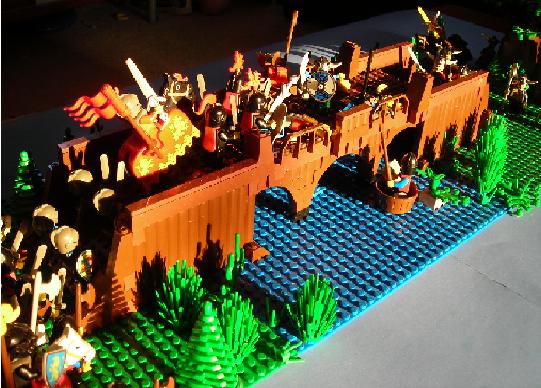 When Edward the Confessor died he left no direct heir, and the throne of England passed to Harold of Wessex.
When Edward the Confessor died he left no direct heir, and the throne of England passed to Harold of Wessex. Harold's brother Tostig influenced the legendary Viking warrior, King Harald Hardrada of Norway to invade England.
Harold's brother Tostig influenced the legendary Viking warrior, King Harald Hardrada of Norway to invade England.
While a second claimant to the throne of England, William of Normandy, labored to launch his own invasion fleet, the Norwegians sailed by way of the Orkneys and landed at Riccall, near York with a force probably numbering 10,000 men.

Harold had been well aware of the dual threats to his new kingdom, and he called out his levies. These were free men from the shires who owed two months of military service each year. By September the two months were up and rations were low, so Harold reluctantly released these irregular troops.
This left him with a trained force of about 3000 mounted infantry known as house-carls. When the news came of the Norwegian landing, Harold quickly marched his men north by the old Roman road known as Watling Street.

The Earls of Northumbria and Mercia, Morcar and Edwin, advanced their men from York and met Harald Hardrada at Fulford on September 20. The experienced Norwegian commander completely routed the earls, depriving King Harold of valuable allies for the fatal battle with the Normans which lay ahead.
The Norsemen appointed Stamford Bridge as a meeting place for an exchange of hostages with the city of York. The confident victors of Fulford were relaxing in the meadows surrounding this crossroads 12 miles from York when to their shock they saw a fresh Saxon army streaming up from the South.


Well, perhaps "fresh" is too strong a word, for Harold had just pushed his men an amazing 180 miles in 4 days, and they were doubtless exhausted. The Norsemen were caught completely off-guard; most had discarded their mail shirts and helmets in the hot sun. They were soon to pay for their carelessness.
The Battle
A desperate delaying action by the Norwegian outposts kept the Saxons from crossing the Derwent while the main army frantically donned their gear and took up position. One anonymous Norwegian held the bridge alone until he was stabbed from beneath the planks of the bridge with a long spear.
A desperate delaying action by the Norwegian outposts kept the Saxons from crossing the Derwent while the main army frantically donned their gear and took up position. One anonymous Norwegian held the bridge alone until he was stabbed from beneath the planks of the bridge with a long spear.

The Norse formed a shield wall in the shape of a triangle, to present a narrow front. The Saxons battered at the wall in a fierce hand to hand fight that lasted all day, before the legendary Harald Hardrada was felled by a Saxon missile. Earl Tostig tried vainly to rally the demoralized men, but the Norse resistance crumbled and the battle became a rout.
The Vikings fled, to be pursued all the way back to their fleet at Riccall. Only 24 ships out of an initial 200 or more made the return to Norway. Before the battle Harold swore that the Norse leader would get "only seven feet of English soil" for his invasion, and he kept the vow, though Harald's remains were later taken back to Norway. As for Tostig, he was buried in York.


The Results
Stamford Bridge ended the long Viking threat to England. Although Stamford Bridge was a great triumph for Harold and the Saxons, their strength was sadly depleted by the fight. And now they faced an even greater foe as news arrived that Duke William of Normandy had landed in Sussex. The weary Saxons turned south once more and marched back as quickly as they had come. They met the Normans at the fateful Battle of Hastings.


No comments:
Post a Comment